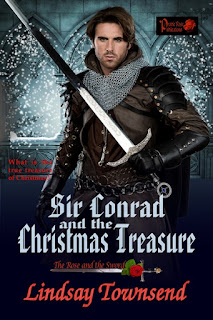Today I’m talking a bit about some lost medieval treasures that I would love to find.
With such a spectacular loss, conspiracies have added to the story. There is a legend that a monk called Brother Simon made off with the jewels, selling them round Europe to add riches to the Templar order. There is also a claim that the wily King John arranged for the jewels to 'disappear'. If he did, he didn't live to benefit from it - a few nights after that unfortunate crossing, he died of his illness. He was buried at Worcester, without any crowns.
What would these missing jewels have looked like? Were they even crowns? We know that King John loved collecting jewels and that he owned silver and gold plate. He also had the regalia he'd inherited from the Empress Maud. This regalia is missing from an inventory used by John's son Henry at his coronation as Henry III in 1220, so it would seem they were lost. However Roger de Wendover’s Flores Historiarum (Flowers of History), written around 1230, says that the lost treasure was ‘precious vessels, and all the other things which he cherished with special care’. Ralph of Coggeshall’s Chronicon Anglicanum says it was ‘his chapel with its relics … and diverse household effects’. None of these items sound like crowns or regalia.
There are surviving crowns from later periods, especially from the time of King Richard II. In his reign he ordered that a treasure roll be drawn up, inventorying the crowns and jewels in his household. There are crowns (eleven of them), chaplets, brooches, circlets, small jewels, cups and ewers. The only surviving crown, sent to Bavaria for the marriage of Henry IV's daughter Blanche, is certainly very beautiful. Given the skill of goldsmiths throughout the ages, from Sutton Hoo, the Staffordshire Hoard and onwards, I imagine the jewels John lost were spectacular. If I could somehow dig down over twenty feet of silt (knowing first where to dig!), I would love to rediscover them.
People have always hidden and lost treasure, or used it in ways different to what the original owners or creators intended. In "Sir Conrad and the Christmas Treasure" - which takes place before the reign of the unfortunate King John - the heroConrad and heroine Maggie are taken to see a holy relic. It is a gold torc and quite spectacular.
Excerpt.
Curious where he had not been greatly intrigued before, merely staying with Maggie to ensure she was safe, Conrad waited for the smoke of the priest’s spitting, damp torch to settle, and then looked for himself.
So much bright gold, was his first thought, while his brother Richard, naturally stretched out sticky fingers to paw at the pieces and Earl John intoned, “Roman, or earlier, and fit for a king.”
“This is the holy moon torc of Saint Oswald!” snapped the priest, keen to put the church’s ownership beyond doubt, “Discovered in a pond near here by my great-grandfather!”
“I have heard tell of such sacred wonders before,” said Conrad, hoping to prevent the priest and earl from saying more in anger or gold-greed that they could not take back.
Here is the torc I had in mind:
Lindsay Townsend
Link to Sir Conrad and the Christmas Treasure here




Lost treasures. those stories are some of the best. Here, of course, it's the 'lost gold mines'. I think you have a better chance of finding the jewels that they do finding lost mines.
ReplyDeleteI enjoyed this post so much. Thank you. Doris
Thanks, Doris! I agree, although finding this 'loot' would be lovely...
ReplyDeleteThat is a spectacular crown. It's stunning, and more feminine than any others I've seen. There must be so many buried treasures, lost or deliberately hidden around the British Isles. It would be amazing to find John's lost crown jewels.
ReplyDeleteAgreed, Christine. I love this crown. Some of the Byzantine ones shown in mosaics and wall paintings also look superb.
ReplyDelete